
Fagonia is a genus of wild, flowering plants in the caltrop family, Zygophyllaceae, having about 34 species. The latest reorganization of the genus took place in 2021 when systematists Christenhusz & Byng included Fagonia spp.. along with several other Zygophyllum genera, into a new genus named "Zygophyllum L." Species occurring in the US are commonly referred to as fagonbushes. The distribution of the genus includes parts of Africa, the Mediterranean Basin, the Mid-East, India, and parts of the Americas. Fagonia species have been used ethnobotanically by traditional practitioners under Ayurvedic and other TM healing regimes for many maladies. Species occur in deserts, dry washes, ditches and on rocky outcrops, including at altitude.

Allium crispum is a species of wild onion known by the common name crinkled onion. It is endemic to California, where it grows along the Central Coast in the Coast Ranges and in the Santa Monica Mountains, often in clays and serpentine soils. It is a perennial herb that is typically found in the foothill woodlands and valley grasslands of California.
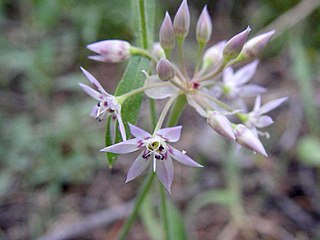
Allium campanulatum is a species of wild onion known by the common name dusky onion or Sierra onion. This is a flowering plant native to the western United States from southeastern Washington and northern Oregon to southern California, and western Nevada. The dusky onion grows in foothills and mountains, especially in dry areas, such as chaparral habitats.
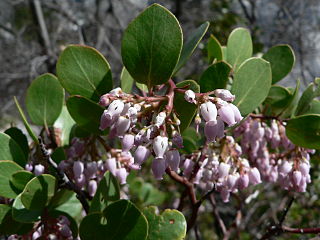
Arctostaphylos patula is a species of manzanita known by the common name greenleaf manzanita. This manzanita is native to western North America where it grows in coniferous forests at moderate to high elevations.

Fagonia laevis, the California fagonbush, is a species of plant in the Zygophyllaceae, the caltrop family. It is a perennial subshrub of the southwestern United States and Northwestern Mexico desert regions in California, southern Nevada, Arizona, southwest Utah, Sonora, Baja California and Baja California Sur. It thrives upon hot, dry, slopes and hillsides that also receive seasonal-(winters of the Southwest) or monsoon moisture.

Fagonia cretica is a species of plant in the caltrop family (Zygophyllaceae). It is native to dry regions of the Mediterranean Basin in North Africa, Southern Europe and West Asia.
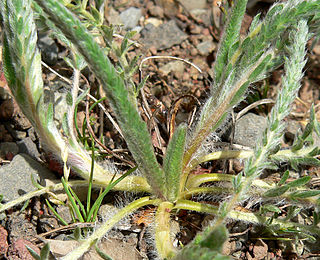
Ivesia sericoleuca is a species of flowering plant in the rose family known by the common name Plumas mousetail, or Plumas ivesia.

Allium abramsii is a species of wild onion known by the common name Abrams' onion.

Arctostaphylos osoensis is a species of manzanita known by the common name Oso manzanita. It is endemic to San Luis Obispo County, California, where it is known from only two occurrences on the northern edge of the Los Osos Valley.

Arctostaphylos purissima is a species of manzanita known by the common name La Purisima manzanita.

Astragalus bolanderi is a species of milkvetch known by the common name Bolander's milkvetch. It is native to western Nevada and parts of the Sierra Nevada in California. It grows in dry, rocky habitat on mountain and plateau.

Astragalus congdonii is a species of milkvetch known by the common name Congdon's milkvetch. It is a perennial herb that is endemic to central California.
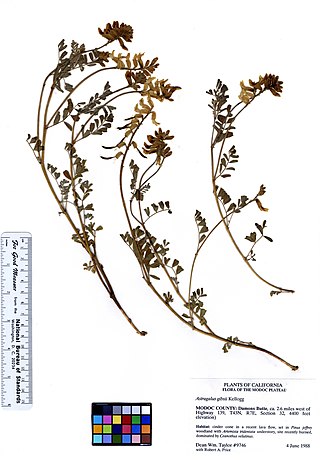
Astragalus gibbsii is a species of milkvetch known by the common name Gibbs's milkvetch. It is native to eastern California, the north-central Sierra Nevada, and western Nevada, where it grows in the pine forest habitat of the mountains and the sagebrush of the plateaus.
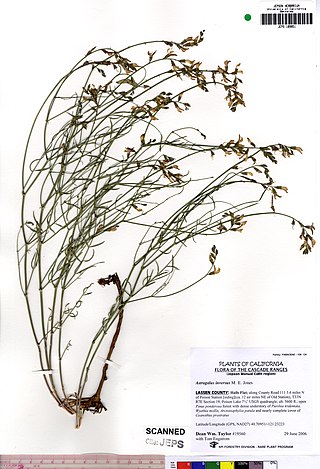
Astragalus inversus is a species of milkvetch known by the common name Susanville milkvetch.

Astragalus shevockii is a rare species of milkvetch known by the common names Little Kern milkvetch and Shevock's milkvetch. It is endemic to Tulare County, California, where it grows in the High Sierra, generally on granite-based soils in Jeffrey pine forests.

Calochortus greenei is a species of flowering plant in the lily family known by the common name Greene's mariposa lily. It is native to northern California and southern Oregon, where it grows in the forest and woodlands of the mountains. It is a perennial herb which produces a branching stem up to about 30 centimeters in maximum height. There is a basal leaf about 20 centimeters long which does not wither at flowering. The inflorescence bears 1 to 5 erect bell-shaped flowers. Each flower has three sepals and three light purple petals with darker areas at the bases. The petals are 3 to 4 centimeters long and have a coat of long hairs on their inner surfaces. The fruit is a winged capsule about 2 centimeters long.

Calochortus vestae is a California species of flowering plants in the lily family known by the common name coast range mariposa lily. It is grows primarily in the forests of the North Coast Ranges of California, with additional populations in the southernmost Cascades in Shasta County and also in foothills of the Sierra Nevada. It generally grows in clay soils.

Cirsium andrewsii is an uncommon species of thistle known by the common name Franciscan thistle. It is endemic to California, where it is known from the coastline of the San Francisco Bay Area from Marin to San Mateo Counties. There are also reports of isolated populations in the Klamath Mountains and in the Sierra Nevada.

Cirsium mohavense is a species of thistle known by the common names virgin thistle and Mojave thistle. It is native to the southwestern United States, where it grows in moist areas in otherwise dry habitat, such as desert springs. It is most common in the Mojave Desert, found also in the southern Great Basin and other nearby regions of California, Nevada, western Arizona, and southwestern Utah.

Clarkia virgata is a species of flowering plant in the evening primrose family known by the common name Sierra clarkia. It is endemic to California, where it is known from the forests and woodlands of the Sierra Nevada.





















